Mitsubishi Fuso Canter
| Mitsubishi Fuso Canter | |
|---|---|
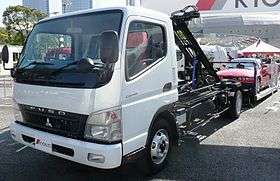 | |
| Overview | |
| Manufacturer | Mitsubishi Fuso Truck and Bus Corporation |
| Also called |
Mitsubishi Fuso Colt Diesel Mitsubishi Fuso FE Sterling 360 |
| Production | 1963-present |
| Assembly |
Cairo, Egypt (Ghabbour Group) Tramagal, Portugal Cainta, Rizal, Philippines (1964-2015)[1] Sta. Rosa, Laguna, Philippines (Jan 2015-Present)[2] Barcelona, Anzoategui, Venezuela Pekan, Malaysia (Malaysia Truck & Bus), Arifiye, Sakarya, Turkey (Temsa) Naberezhnye Chelny, Russia (Fuso KAMAZ Trucks Rus) |
| Body and chassis | |
| Class | Truck |
| Body style | Truck (standard cab, crew cab) |
| Powertrain | |
| Engine | Mitsubishi 117 HP (1983-1995), Mitsubishi 135 HP (1995-2004), Mitsubishi 175 HP (2004-) |
| Transmission | Mitsubishi (manual), Aisin (automatic) |
The Mitsubishi Fuso Canter (kana: 三菱ふそう・キャンター) is a line of light-duty commercial vehicle manufactured by Mitsubishi Fuso Truck and Bus Corporation since 1963. The range is currently marketed in Japan, Europe, Australia, New Zealand, Indonesia and a number of other Asian countries, as well as in the United States. The same range has been marketed by Mitsubishi Fuso Truck of America in North America since 1985, though it was called the FE model rather than the Canter until the 2012 model year. The Canter is named after the English word describing the gallop of a horse, emphasising the 'thoroughbred' nature of Mitsubishi trucks.
Overview
The Canter nameplate was first introduced in March 1963 for the existing T20 range of light-duty trucks.[3] The preceding series originated with the "T710" of 1960. These early models were sold almost entirely in Asia. The Asia-Pacific was the main market for the Canter until the early 1970s. Later the series began seeing export or local manufacture in markets including Europe, the Middle-East and North America. In many markets the Canter was very expensive and was replaced by the Mitsubishi Fuso Truck when that model became available for worldwide market in the early 1980s.
Australia was another important market for the Canter - to the extent that it was manufactured there from the 1970s using many local components. European sales began in the Benelux countries in the late 1970s. About 200 of the narrow cabined fourth generation Canters were sold there by 1980, when local assembly of a wide bodied Canter in Belgium by importer Moorkens N V was begun on a trial basis.[4] The Canter ended up manufacturing in Tramagal, Portugal instead, since 1980.[5] Tramagal is located 150 km north of Lisbon. The factory achieves a production capacity of 15,000 units per year and shift with approximately 430 employees (October 2004). More than 110,000 vehicles have been produced here to date. High production quality, certified with ISO-standards, combined with a rigorous test program and extensive final inspection and quality checks lead to a tough and reliable truck.
Most models of the truck are distinguishable by a front 'Canter' badge, but the common Mitsubishi badge is usually used on the rear.
In the United States, its principal competitors were historically Bering MS, Chevrolet W-Series, GMC W-Series, Isuzu NPR/NQR and the UD 1200/1300/1400, although Bering, and Chevrolet/GMC have ceased their production of competitive models. In Japan, competitors are Isuzu Elf, UD Atlas, Toyota Dyna, Hino Dutro.
In late 2005, a new Canter was presented, with safety being the main issue. Also a new hybrid truck, the Canter Eco Hybrid was presented commercially.
In the United Kingdom the Sales and Marketing headquarters of Mitsubishi Fuso is located in Milton Keynes at the headquarters of Daimler, sitting within the Commercial Vehicle division alongside Mercedes-Benz. At a local level, Mitsubishi Fuso Canter is Sold and Supported through the Mercedes-Benz commercial vehicle network.
More information on the new Euro 5 models [here]
The European market is supplied exclusively with Canter vehicles from the Mitsubishi Fuso assembly plant in Tramagal (Portugal).[5] Currently engines by Fiat Powertrain Technologies and transmission by ZF Friedrichshafen are installed in Canter vehicles since 2009. To comply with the rules in force in Japan from 2015 stricter emission standards, now, all Canter models use the same 4-stroke, water-cooled, turbocharged, intercooled DOHC4 FPT Industrial F1C diesel engine as the Fiat Ducato and Iveco Daily, and are sold in all markets.[6]
In Indonesia, The Mitsubishi Fuso Canter was named as Colt Diesel. It's rare to use "Colt Diesel".
Models
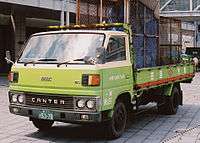
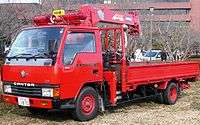

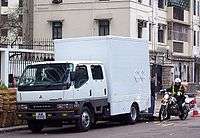

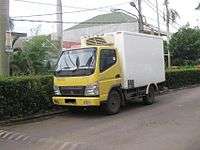
Japan
- FB Canter Guts
- FD Canter Guts 4WD
- FE jones
- FF Tri-axles
- FG 4WD
US & Canada
- Canter FE Light-Medium Duty
- FE-HD
- FE-SP
- FE-SP640
- FE84
- FE85D
- FE120
- FE140
- FE145
- FE145CC
- FE180
- FE335B
- FE434
- FE439
- FE444
- FE635
- FE639
- FE639L
- FE639T
- FE640T
- FE649L
- FE649T
- FE1600
- Canter FG Light-Medium Duty 4WD
- FG140
- FG439
- Canter FH Medium Duty
- FH210
- FH211
- Sterling 360
Europe
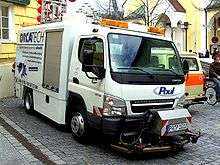
- Canter FB, FE, FH
- 3.5 ton
- 5.5 ton
- 6.5 ton
- 7.5 ton
Turkey (Euro 5 models)
- TF A35 (3.5 ton, narrow cab)
- TF A35L (3.5 ton, narrow cab, long wheelbase)
- TF B35 (3.5 ton, wide cab)
- TF B75 (7.5 ton, wide cab)
- TF B75L (7.5 ton, wide cab, long wheelbase)
All of models are available with Duonic dual clutch gearbox.
New Zealand
- Canter FB, FE, FH
- 2.0T FE130C1 Super Low
- 2.0T FE150C1 Wide cab
- 2.0T FE150E1 Wide Cab
- 2.5T FG145C1 4x4
- 3.5T FE150E2 Wide cab
- 3.5T FE150W1 Double Cab
- 4.0T FE150G1 Wide Cab
- 4.5T FE150G2 Heavy Duty Wide Frame
Australia
All models available with either manual or duonic (dual clutch AMT) transmission, unless stated otherwise.[7]
- Canter FE (4x2)
- 413 City (Narrow) Cab SWB
- 515 City (Narrow) Cab SWB/MWB (Duonic only)
- 515 City (Narrow) Cab Tipper SWB
- 515 City (Narrow) Crew Cab MWB (Duonic only)
- 515 Wide Cab SWB/MWB
- 615 Wide Cab MWB/LWB
- 715 Tipper SWB
- 815 Wide Cab MWB/LWB
- 815 Eco-Hybrid MWB/LWB (Duonic only)
- 815 Crew Cab MWB (Duonic only)
- 918 Wide Cab MWB/LWB/XLWB/XXLWB
- 918 Crew Cab MWB/LWB/XLWB
- Canter FG (4x4)
- 715 Wide Cab MWB (Manual only)
- 715 Crew Cab MWB (Manual only)
sri lanka
In Indonesia, the locally assembled Mitsubishi Fuso Canter is marketed as Colt Diesel.
- 4-wheel
- FE71
- FE71 SUPER CAPACITY
- 6-wheel
- FE73
- FE73 SUPER POWER
- FE74
- FE74 SUPER SPEED
- FE74 SUPER POWER
- FE75
- FE75 SUPER POWER
- FE84
- FE84 SUPER CAPACITY AND SUPER POWER
Philippines
- Canter
- FE71
- FE83
- FE85
- FG83
See also
References
- ↑ Sarne, Vernon (2013-05-30). "Mitsubishi PH president wants new model, more units made in Cainta". Top Gear Philippines. Retrieved 2013-05-30.
- ↑ "Mitsubishi Motors Philippines inaugurates its Sta. Rosa, Laguna Plant". Mitsubishi Motors Philippines Corporation. 2015-01-29.
- ↑ Ozeki, Kazuo (2007).
日本のトラック・バス 1918~1972 [Japanese Trucks and Buses 1918-1972:] (in Japanese). Tokyo: Miki Press. p. 113. ISBN 978-4-89522-494-9. - ↑ Kennett, Pat, ed. (June 1980). "Truckchat". TRUCK. London, UK: FF Publishing Ltd: 13.
- 1 2 "Made in Europe for Europe". FUSO Trucks Europe. Retrieved 22 March 2016.
- ↑ "Strategic Cooperation Agreement between DaimlerChrysler Truck Group and Fiat Powertrain Technologies" (PDF). FPT Industrial. June 19, 2007. Retrieved 22 March 2016.
- ↑ http://www.fuso.com.au/Canter
External links
| Wikimedia Commons has media related to Fuso Canter. |
- Official UK Canter website
- Mitsubishi Canter Dealer East Anglia
- Mitsubishi Fuso Japan (second group is Canter's)
- Mitsubishi Fuso Canter Worldwide - 1st site, 2nd site
- Mitsubishi Fuso Canter USA - FE, FE Crew, FG
- Mitsubishi Fuso Canter Europe
- Mitsubishi Fuso Canter Australia
- Mitsubishi Fuso Canter New Zealand
- Mitsubishi Fuso Canter South Africa
- Information on Canters in the UK
- Mitsubishi Fuso Canter Russia
- Mitsubishi Fuso Russia Saint-Petersburg
- Mitsubishi Fuso Canter Turkey
India:
In India The 5th Gen Canter Was Available But The 6th Gen Canter Was Discontinued Owing To Poor Sales.